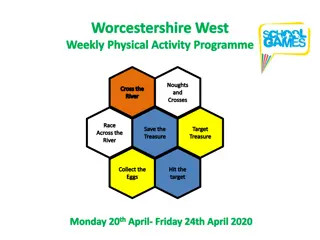Educational Weekly Overview for October 19-23, 2020
This weekly overview outlines the learning targets and priorities for two units - Number System Fluency and Earth's Changing Landscape. It includes details on class activities, assignments, and assessments related to interpreting word problems, dividing fractions, identifying rocks, and more. The agenda provides a structured outline for each day's activities, ensuring students engage with key concepts effectively.
Download Presentation

Please find below an Image/Link to download the presentation.
The content on the website is provided AS IS for your information and personal use only. It may not be sold, licensed, or shared on other websites without obtaining consent from the author.If you encounter any issues during the download, it is possible that the publisher has removed the file from their server.
You are allowed to download the files provided on this website for personal or commercial use, subject to the condition that they are used lawfully. All files are the property of their respective owners.
The content on the website is provided AS IS for your information and personal use only. It may not be sold, licensed, or shared on other websites without obtaining consent from the author.
E N D
Presentation Transcript
Week AT A Glance (WAG) October 19-23, 2020
Unit 1: Number System Fluency Learning Target(s) of the Week Priority Standards MGSE6.NS.1 I can interpret and solve word problems involving division of fractions applying the relationship between multiplication and division to justify my answer. I can represent the context of a fraction word problem using a variety of models. Supporting Standards MGSE6.NS.4, 4b I can find the greatest common factors (up to 100) and least common multiple (less than or equal to 12) of two whole numbers. I can use the distributive property to express a sum of two whole numbers with a common factor as a multiple of a sum of two numbers with no common factor.
Unit 1: Earths Changing Landscape Learning Target(s) of the Week Priority Standards S6E5c I can classify rocks based on their physical and chemical properties. I can develop a model to show how rocks are changed. Supporting Standard S6E5b I can identify the mineral composition of rocks.
Learning Target(s) of the Week AGENDA Priority Standards MGSE6.NS.1 I can interpret and solve word problems involving division of fractions applying the relationship between multiplication and division to justify my answer. Class Opener - Warm-Up: What is the Greatest Common Factor for 3 and 6? Whole Group Students and Teachers will complete Module 4.1 in the Online Textbook for Multiplying fractions. I can represent the context of a fraction word problem using a variety of models. Closing TOTD: Number Fluency Question Supporting Standards MGSE6.NS.4, 4b I can find the greatest common factors (up to 100) and least common multiple (less than or equal to 12) of two whole numbers. Asynchronous Period Complete Multiplying Fractions Module 4.1 Worksheet. Homework- Greatest Common Factor Frayer Model I can use the distributive property to express a sum of two whole numbers with a common factor as a multiple of a sum of two numbers with no common factor.
AGENDA Learning Target(s) of the Week Class Opener Science Do Now: How are rocks classified? Priority Standards S6E5c I can classify rocks based on their physical and chemical properties. I can develop a model to show how rocks are changed. Whole Group Whole Group Rock Cycle Study Jams and How are rocks classified Cornell Notes Closing TOTD Lab discussion questions Supporting Standard S6E5b I can identify the mineral composition of rocks. Asynchronous Period Complete Cornell Notes Homework- Complete Incomplete Assignments
Learning Target(s) of the Week AGENDA Priority Standards MGSE6.NS.1 I can interpret and solve word problems involving division of fractions applying the relationship between multiplication and division to justify my answer. Class Opener - Warm-Up: What is the Least Common Multiple for 15 and 6? Whole Group Students and Teachers will complete Module 4.1 in the Online Textbook for Adding and Subtracting fractions. I can represent the context of a fraction word problem using a variety of models. Closing TOTD: Number Fluency Question Supporting Standards MGSE6.NS.4, 4b I can find the greatest common factors (up to 100) and least common multiple (less than or equal to 12) of two whole numbers. Asynchronous Period Complete Adding and Subtracting Module 4.1 Worksheet. Homework- Least Common Multiple Frayer Model I can use the distributive property to express a sum of two whole numbers with a common factor as a multiple of a sum of two numbers with no common factor.
Class Opener Science Do Now: What is an igneous rock Priority Standards S6E5c I can classify rocks based on their physical and chemical properties. I can develop a model to show how rocks are changed. Whole Group Review Rock Cycle game Name that rock game Closing TOTD Lab Discussion Answers Supporting Standard S6E5b I can identify the mineral composition of rocks. Asynchronous Period Create a Rock Cycle Model Homework- Complete Incomplete Assignments
Math Complete 1 iReady Lesson Module 4.1 Quiz Complete Asynchronous work from the week Complete Incomplete Assignments Science Complete Asynchronous work from the week Complete Incomplete Assignments
For additional support, please see pages 79-81 in your "Go Math" online textbook. You may also visit the "Math on the Spot" for module 4.1 for support as well. Tutoring times for the teacher is between 11-11:50 Monday and Wednesday. Times will be setup in advance. You may also use the FEV tutor resource as well.
For additional support, please see your online textbook. You may also visit https://sciencespot.net for many interactive science activities and information for support as well. Tutoring times for the teacher is between 11-11:50 Monday -Thursday. Times will be setup in advance. You may also use the FEV tutor resource as well.























